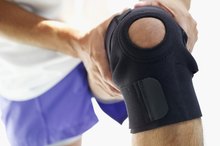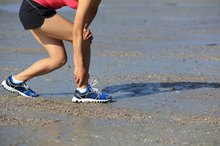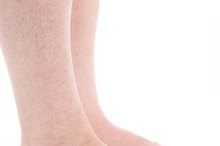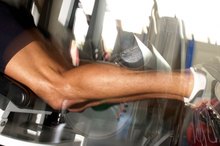Causes of Shin and Ankle Pain While Running
According to the American Academy of Orthopedic Surgeons, runners are more susceptible to injuries than the average person 123. Some of these injuries can cause pain to the muscles surrounding the ankle and shin. While many of the injuries can be alleviated with rest, some create more serious complications. If you are having ankle or shin muscle pain while running, you should stop and have your pain evaluated by a doctor.
If you are experiencing serious medical symptoms, seek emergency treatment immediately.
Ankle Muscle Pain
A common cause of ankle muscle pain caused by running is a strain, or tears along the muscles or joints of the ankle. They can be from an acute injury or trauma, or they can be chronic from overuse. The repetitive movements of running, without proper rest, can easily cause an ankle strain. Another cause is a sprain, which is a tear of ligament fibers rather than muscles. Because it may be difficult to differentiate between a strain and a sprain, it is important to be evaluated by a doctor.
- A common cause of ankle muscle pain caused by running is a strain, or tears along the muscles or joints of the ankle.
- The repetitive movements of running, without proper rest, can easily cause an ankle strain.
Shin Muscle Pain
Unexplained Shooting Pain in My Shins
Learn More
Shin splints, a common cause:
- of shin pain among runners
- is an inflammation of the muscles
- tendons
- outer covering of the front of the shin bone
- or tibia
It is caused by the repetitive pressure along the shin, and occurs more often in runners with flat feet.. A rare but serious condition causing pain to the muscles surrounding the shin is called chronic exertional compartment syndrome, which occurs when blood cannot flow properly because of pressure within the muscle compartment. The pain is usually intense, occurs after exertion and is relieved with rest. The only permanent treatment for this condition is surgery.
Prevention
There are steps you can take to prevent muscle pain in the ankles and shins, including wearing properly fitting shoes and having a professional check your running gait to help you find the best shoes to run in. Another option is taking a day off and resting at least every three days between runs. Stretching before and after running will stretch out the muscles surrounding the ankles and shins.
Treatment
Exercises for Tendonitis of the Foot
Learn More
RICE stands for rest, ice, compression, and elevation. Resting for a period of time, depending on the injury, can help heal the cause of your pain. Decreasing swelling by icing the painful area for 20 minutes several times daily, using a compression bandage and elevating the affected extremity above the heart will also help. Taking anti-inflammatory medication will provide relief by decreasing inflammation, but check with your doctor first.
- RICE stands for rest, ice, compression, and elevation.
- Decreasing swelling by icing the painful area for 20 minutes several times daily, using a compression bandage and elevating the affected extremity above the heart will also help.
Related Articles
References
- American Academy of Orthopedic Surgeons: Compartment Syndrome
- American Academy of Orthopedic Surgeons: Sprained Ankle
- American Academy of Orthopedic Surgeons: Shin Splints
- Runners Rescue: Ankle Sprains and Running
- Alaia MJ. Diseases & Conditions: Shin Splints. OrthoInfo. American Academy of Orthopaedic Surgeons. Reviewed August 2019.
- Shin Splints. Merck Manual Professional Version.
- Callahan LR. Overview of running injuries of the lower extremity. UpToDate. Updated May 28, 2020.
- Shin splints - self care. MedlinePlus NIH.
Resources
Writer Bio
Kristi Croddy, BSN, is a registered nurse who started writing in 1994. She volunteers as a lactation consultant and pregnancy coach. Her writing career includes articles on pregnancy health, childbirth and breastfeeding. She is currently working on her first book, "Pain Free Delivery: A Guide to Natural Childbirth."








